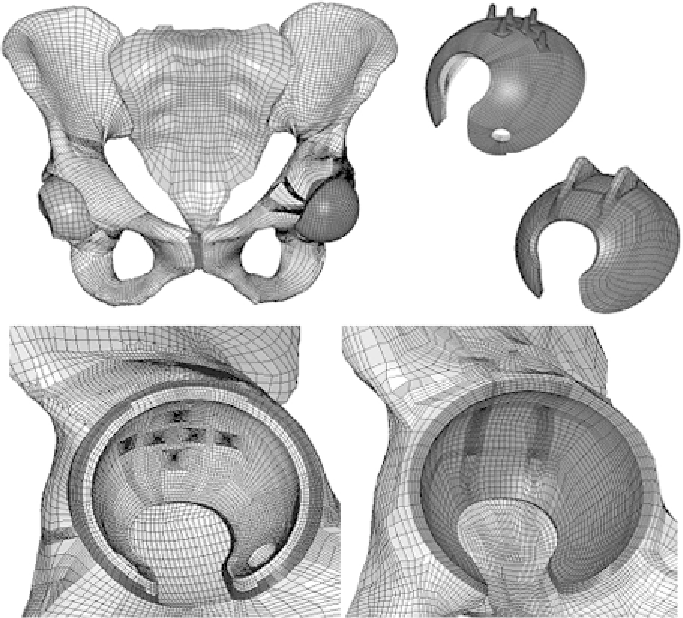Biomedical Engineering Reference
In-Depth Information
Figure 14.13
FE meshes of the
(clockwise from top left)
implanted hip, Cambridge Cup,
MITCH
-
PCRpelvis, andCambridge pelvis.
-PCR Cup, MITCH
An initial site-specific internal bone remodeling
stimulus was also evaluated for the MITCH
(maximum principal stress: 26.8 MPa; von Mises
stress: 23.2 MPa) were much lower than the tensile
and yield strengths of 170 and 130 MPa for CFR-
PEEK, respectively, as reported by the manufacturer.
Our study has illustrated the influence of a flexible
horseshoe-shaped cup design on the stress and strain
distribution in the periprosthetic acetabulum. We were
encouraged to find that the MITCH
-PCR
Cup, Cambridge Cup, and conventional hemi-
spherical cups. In our analysis, site-specific changes
in strain energy of more than 75% for the cup relative
to the natural pelvis would predict remodeling. We
interpreted a positive change in stimulus to promote
formation and a negative change to cause resorption.
The MITCH
-PCR Cup and
the Cambridge Cup both produced semilunar peri-
prosthetic stress distributions, consistent with contact
regions measured in vitro for the natural hip
[64]
.The
compressive stresses and strain fields for both horse-
shoe-shaped cups were slightly modified from those
predicted by our model of the natural hip. However,
they were more physiologic than the stress and strain
fields we reported earlier with conventional hemi-
spherical design
[63]
. In the hemispherical cupmodels,
nonphysiologic strain transfer occurred around the
acetabular fossa, along with reductions in maximum
compressive stresses of 33%. Bone remodeling stim-
ulus predictions suggested that stress shielding may be
inevitable in well-fixed metal-backed hemispherical
designs (
Fig. 14.16
). Similar findings have been
observed in vitro and suggested as a possible mecha-
nism for decreased implant stability over time
[64]
.
-PCR Cup produced compressive
stress (
Fig. 14.14
) and effective (von Mises) strain
(
Fig. 14.15
) distributions in the periacetabular region
that were substantially similar to the Cambridge Cup.
Transverse sections through the MITCH
-PCR Cup
and pelvis parallel to the fins showed transfer of
compressive stresses not only around the peripheral
rim of the acetabulum but also superiorly through fins
to the medial wall of the pelvis. Within the acetab-
ulum, the stress and strain distributions were semi-
lunar, qualitatively similar to the natural hip. A similar
pattern of load transfer was also observed with the
Cambridge Cup, although it appeared that the shallow
pegs were slightly less effective at transferring stresses
and strains through the superior subchondral bone
than the fins on the MITCH
-PCR Cup. The peak-
bearing
stresses
in
the MITCH
-PCR Cup

